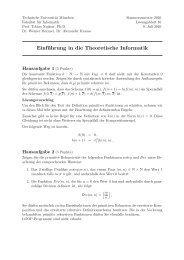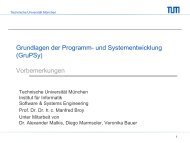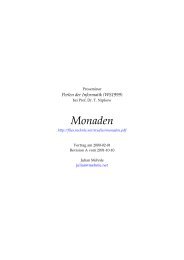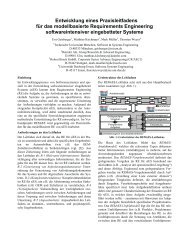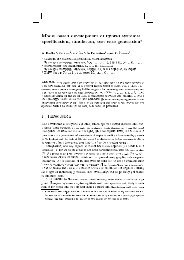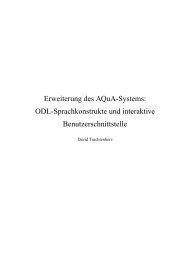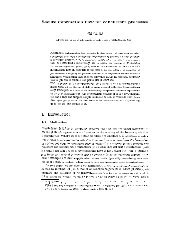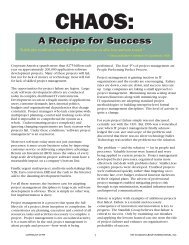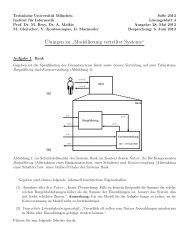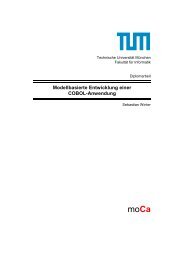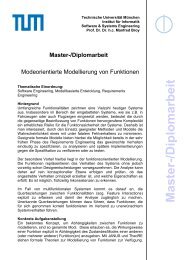A Compiled Implementation of Normalization by ... - Isabelle - TUM
A Compiled Implementation of Normalization by ... - Isabelle - TUM
A Compiled Implementation of Normalization by ... - Isabelle - TUM
You also want an ePaper? Increase the reach of your titles
YUMPU automatically turns print PDFs into web optimized ePapers that Google loves.
A <strong>Compiled</strong> <strong>Implementation</strong><strong>of</strong> <strong>Normalization</strong> <strong>by</strong> EvaluationKlaus Aehlig 1⋆ and Florian Haftmann 2⋆⋆ and Tobias Nipkow 21 Department <strong>of</strong> Computer Science, Swansea University2 Institut für Informatik, Technische Universität MünchenAbstract. We present a novel compiled approach to <strong>Normalization</strong> <strong>by</strong>Evaluation (NBE) for ML-like languages. It supports efficient normalization<strong>of</strong> open λ-terms w.r.t. β-reduction and rewrite rules. We haveimplemented NBE and show both a detailed formal model <strong>of</strong> our implementationand its verification in <strong>Isabelle</strong>. Finally we discuss how NBE isturned into a pro<strong>of</strong> rule in <strong>Isabelle</strong>.1 IntroductionSymbolic normalization <strong>of</strong> terms w.r.t. user provided rewrite rules is one <strong>of</strong> thecentral tasks <strong>of</strong> any theorem prover. Several theorem provers (see §5) provideespecially efficient normalizers which have been used to great effect [9,14] in carryingout massive computations during pro<strong>of</strong>s. Existing implementations performnormalization <strong>of</strong> open terms either <strong>by</strong> compilation to an abstract machineor <strong>by</strong> <strong>Normalization</strong> <strong>by</strong> Evaluation, NBE for short. The idea <strong>of</strong> NBE is to carryout the computations <strong>by</strong> translating into some underlying functional language,evaluating there, and translating back. The key contributions <strong>of</strong> this paper are:1. A novel compiled approach to NBE that exploits the pattern matching alreadyavailable in a decent functional language, while allowing the normalization<strong>of</strong> open λ-terms w.r.t. β-reduction and a set <strong>of</strong> (possibly higher-order)rewrite rules.2. A formal model and correctness pro<strong>of</strong> 3 <strong>of</strong> our approach in <strong>Isabelle</strong>/HOL [15].NBE is implemented and available at the user-level in <strong>Isabelle</strong> 2007, both toobtain the normal form t ′ <strong>of</strong> some given term t, and as a pro<strong>of</strong> rule that yieldsthe theorem t = t ′ .Throughout the paper we refer to the underlying functional language as ML.This is only for brevity: any language in the ML family, including Haskell, issuitable. However, we assume that the language implementation provides itsown evaluator at runtime, usually in the form <strong>of</strong> some compiler. The guiding⋆ Partially supported <strong>by</strong> grant EP/D03809X/1 <strong>of</strong> the British Engineering and PhysicalSciences Research Council (EPSRC).⋆⋆ Supported <strong>by</strong> DFG grant Ni 491/10-13 Available online at afp.sf.net
principle <strong>of</strong> our realization <strong>of</strong> NBE is to <strong>of</strong>fload as much work as possible ontoML: not just substitution but also pattern matching. Thus the word ‘compiled’in the title refers to both the translation from the theorem prover’s λ-calculusinto ML and from ML to some <strong>by</strong>te or machine code. The trusted basis <strong>of</strong> thetheorem prover is not extended if the compiler used at runtime is the same asthe one compiling the theorem prover.2 <strong>Normalization</strong> <strong>by</strong> Evaluation in ML<strong>Normalization</strong> <strong>by</strong> Evaluation uses the evaluation mechanism <strong>of</strong> an underlyingmetalanguage to normalize terms, typically <strong>of</strong> the λ-calculus. By means <strong>of</strong> anevaluation function [·] ξ , or, alternatively <strong>by</strong> compiling and running the compiledcode, terms are embedded into this metalanguage. In other words, we now havea native function in the implementation language. Then, a function ↓, which actsas an “inverse <strong>of</strong> the evaluation functional” [5], serves to recover terms from thesemantics. This process is also known as “type-directed partial evaluation” [7].<strong>Normalization</strong> <strong>by</strong> Evaluation is best understood <strong>by</strong> assuming a semanticsenjoying the following two properties.– Soundness: if r → s then [r] ξ = [s] ξ , for any valuation ξ.– Reproduction: if r is a term in normal form, then ↓ [r] ↑ = r with ↑ a specialvaluation.These properties ensure that ↓ [r] ↑ actually yields a normal form <strong>of</strong> r if it exists.Indeed, let r → ∗ s with s normal; then ↓ [r] ↑ =↓ [s] ↑ = s.We implement untyped normalization <strong>by</strong> evaluation [1] in ML. To do so, weneed to construct a model <strong>of</strong> the untyped λ-calculus, i.e., a data type containingits own function space. Moreover, in order to make the reproduction propertypossible, our model ought to include some syntactical elements in it, like constructorsfor free variables <strong>of</strong> our term language. Fortunately, ML allows datatypes containing their own function space. So we can simply define a universaltype Univ like the following.datatype Univ =Const <strong>of</strong> string * Univ list| Var <strong>of</strong> int * Univ list| Clo <strong>of</strong> int * (Univ list -> Univ) * Univ listNote how the constructors <strong>of</strong> the data type allow to distinguish between basictypes and proper functions <strong>of</strong> implementation language. In type-directed partialevaluation such a tagging is not needed, as the type <strong>of</strong> the argument already tellswhat to expect; on the other hand, this need <strong>of</strong> anticipating what argument willcome restricts the implementation to a particular typing discipline, whereas ouruntyped approach is flexible enough to work with any form <strong>of</strong> rewrite calculus.The data type Univ represents the embedding <strong>of</strong> the syntax and the embedding<strong>of</strong> the function space. There is no constructor for application. The reason isthat semantical values <strong>of</strong> the λ-calculus correspond to normal terms, whereas an2
application <strong>of</strong> a function to some other value, in general, yields a redex. Thereforeapplication is implemented <strong>by</strong> a function apply: Univ -> Univ -> Univdiscussed below. The constructor Const serves to embed constructors <strong>of</strong> datatypes <strong>of</strong> the underlying theory; they are identified <strong>by</strong> the string argument. Normalforms can have the shape C t 1 . . . t k <strong>of</strong> a constructor C applied to several(normal) arguments. Therefore, we allow Const to come with a list <strong>of</strong> arguments,for convenience <strong>of</strong> the implementation in reverse order. In a similar manner, theconstructor Var is used to represent expressions <strong>of</strong> the form x t 1 . . . t k with x avariable.The constructor Clo represents partially applied functions. More precisely,“Clo (n, f, [a k ,. . . ,a 1 ])” represents the (n+k)-ary function f applied to a 1 , . . . , a k .This expression needs another n arguments before f can be evaluated. In thecase <strong>of</strong> the pure λ-calculus, n would always be 1 and f would be a value obtained<strong>by</strong> using (Standard) ML’s “fn x => . . . ” function abstraction. Of course,ML’s understanding <strong>of</strong> the function space is bigger than just the functions thatcan be obtained <strong>by</strong> evaluating a term in our language. For example, recursioncan be used to construct representation for infinite terms. However, this willnot be a problem for our implementation, for several reasons. First <strong>of</strong> all, weonly claim that terms are normalised correctly—this suffices for our procedureto be admissible in a theorem prover. During that normalisation process, onlyfunction that can be named <strong>by</strong> a (finite) term will occur as arguments to Clo.Moreover, only needing partial correctness, we will only ever be concerned withsemantical values where our ↓-function terminates. But then, the fact that it didterminate, witnesses that the semantical value has a finite representation <strong>by</strong> one<strong>of</strong> our terms.As mentioned, application is realised <strong>by</strong> an ML-function apply. With thediscussed semantics in mind, it is easy to construct such a function: in the casesthat C t 1 . . . t k or x t 1 . . . t k is applied to a value s, we just add it to the list. Inthe case <strong>of</strong> a partially applied function applied to some value s we either, in casemore then one argument is still needed, collect this argument or, in case this wasthe last argument needed, we apply the function to its arguments.fun apply (Clo (1, f, xs)) x = f (x :: xs)| apply (Clo (n, f, xs)) x = Clo (n - 1, f, x :: xs)| apply (Const (name, args)) x = Const (name, x :: args)| apply (Var (name, args)) x = Var (name, x :: args)It should be noted that the first case in the above definition is the one thattriggers the actual work: compiled versions <strong>of</strong> the functions <strong>of</strong> the theory arecalled. As discussed above, our semantical universe Univ allows only normalvalues. Therefore, this call carries out all the normalization work.As an example, consider a function append defined in some <strong>Isabelle</strong>/HOLtheory T based on the type list defined in theory Listfun append :: "’a list => ’a list => ’a list" where"append Nil bs = bs" |"append (Cons a as) bs = Cons a (append as bs)"3
and assume “append (append as bs) cs = append as (append bs cs)” wasproved. Compiling these equations together with associativity <strong>of</strong> append yieldsthe following ML code.fun T_append [v_cs, Nbe.Const ("T.append", [v_bs, v_as])] =T_append [T_append [v_cs, v_bs], v_as]| T_append [v_bs, Nbe.Const ("List.Cons", [v_as, v_a])] =Nbe.Const ("List.Cons", [T_append [v_bs, v_as], v_a])| T_append [v_bs, Nbe.Const ("List.Nil", [])] =v_bs| T_append [v_a, v_b] =Nbe.Const ("T.append", [v_a, v_b])The second and third clause <strong>of</strong> the function definition are in one-to-one correspondencewith the definition <strong>of</strong> the function append in the theory. The arguments,both on the left and right side, are in reverse order; this is in accordancewith our semantics that fa 1 . . . a n is implemented as “f [a n ,. . . , a 1 ]”.The last clause is a default clause fulfilling the need that the ML patternmatching be exhaustive. But our equations, in general, do not cover all cases.The constructor Var for variables is an example for a possible argument usuallynot covered <strong>by</strong> any rewrite rule. In this situation where we have all argumentsfor a function but no rewrite rule is applicable, no redex was generated <strong>by</strong> thelast application—and neither will be <strong>by</strong> applying this expression to further arguments,as we have already exhausted the arity <strong>of</strong> the function. Therefore, wecan use the append function as a constructor. Using (the names <strong>of</strong>) our compiledfunctions as additional constructors in our universal data type is a necessity <strong>of</strong>normalising open terms. In the presence <strong>of</strong> variables not every term reduces toone built up from only canonical constructors; instead, we might obtain normalforms with functions like append. Using them as additional constructors is theobvious way to represent these normal forms in our universal semantics.Keeping this reproduction case in mind, we can understand the first clause.If the first argument is <strong>of</strong> the form append, in which case it cannot further besimplified, we can use associativity. Note that we are actually calling the appendfunction, instead <strong>of</strong> using a constructor; in this way we ensure to produce anormal result.Continuing the example, now assume that we want to normalise the expression“append [a,b] [c]”. Then the following compiled version <strong>of</strong> this expressionwould be evaluated to obtain an element <strong>of</strong> Univ.(Nbe.apply(Nbe.apply(Clo (2,T_append,[]))(Nbe.Const ("List.cons",[(Nbe.Const ("List.cons",[(Nbe.Const ("List.nil", [])),(Nbe.free "b")])),(Nbe.free "a")])))4
(Nbe.Const ("List.cons", [(Nbe.Const ("List.nil", [])),(Nbe.free "c")])))As discussed, values <strong>of</strong> type Univ represent normal terms. Therefore we caneasily implement the ↓-function, which will be called term in our implementation.The function term returns a normal term representing a given element <strong>of</strong> Univ.For values <strong>of</strong> the form “Const name [v n ,. . . ,v 1 ]” we take the constant C named<strong>by</strong> the string, recursively apply term to v 1 , . . . , v n , obtaining t 1 , . . . , t n , and buildthe application C t 1 . . . t n . Here, again, we keep in mind that arguments are inreverse order in the implementation. The definition in the case <strong>of</strong> a variableis similar. In the case v = “Clo . . . ” <strong>of</strong> a closure we just carry out an etaexpansion: the value denotes a function that needs at least another argument,so we can always write it as λx.term(v x), with x a fresh syntactical variable.Naturally, this application <strong>of</strong> v to the fresh variable x is done via the functionapply discussed above. In particular, this application might trigger a redex andtherefore cause more computation to be carried out. For example, as normalform <strong>of</strong> “append Nil” we obtain—without adding any further equations!—thecorrect function “λu. u”.Immediately from the definition we note that term can only output normalterms. Indeed, the Const construct is used only for constructors or functionswhere the arguments are <strong>of</strong> such a shape that no redex can occur. Expressions<strong>of</strong> the shape x t 1 . . . t k and λx.t are always normal if t, t 1 , . . . , t k are; the latterwe can assume <strong>by</strong> induction hypothesis. Note that we have shown the normality<strong>of</strong> the output essentially <strong>by</strong> considering ways to combine terms that preserve thenormality. In fact, the normalisation property <strong>of</strong> normalisation <strong>by</strong> evaluation canbe shown entirely <strong>by</strong> considering an appropriate typing discipline [8].Compared to the expressivity <strong>of</strong> the underlying term language in <strong>Isabelle</strong>, ouruniversal datatype is quite simple. This is due to the fact, that we consider anuntyped term-rewriting mechanism. This simplicity, however, comes at a price:we have to translate back and forth between a typed and an untyped world.Forgetting the types to get to the untyped rewrite structure is, essentially, aneasy task, even though some care has to be taken to ensure that the moreadvanced <strong>Isabelle</strong> features like type classes and overloading are compiled awaycorrectly and the term to be normalised obeys the standard Hindley-Milner typediscipline. More details <strong>of</strong> this transformation into standard typing discipline aredescribed in §4.From terms following this standard typing discipline the types are thrownaway and the untyped normal form is computed, using the mechanism describedearlier. Afterwards, the full type annotations are reconstructed. To this end, thetypes <strong>of</strong> all free variables have been stored before normalization; the most generaltypes <strong>of</strong> the constants can be uniquely rediscovered from their names. The type<strong>of</strong> the whole expression is kept as well, given that the <strong>Isabelle</strong> object languageenjoys subject reduction. Standard type inference will obtain the most generaltype annotations for all sub-terms such that all these constraints are met.In most cases, these type reconstructions are unique, as follows from thestructure <strong>of</strong> normal terms in the simply-typed lambda calculus. However, in5
the presence <strong>of</strong> polymorphic constants, the most general type could be moregeneral than intended. For example, let f be a polymorphic constant <strong>of</strong> type“(’a => ’a) => bool”, say without any rewrite rule. Then the untyped normalform <strong>of</strong> “f (λu::bool. u)” would be “f (λu. u)” with most general typeannotations “f (λu::’a. u)”. To avoid such widening <strong>of</strong> types only those equationswill be considered as being proved <strong>by</strong> normalization where the typing <strong>of</strong>the result is completely determined, i.e., those equations, where the most generaltype for the result does not introduce any new type variables. It should be notedthat this, in particular, is always the case, if an expression evaluates to True.3 Model and VerificationThis section models the previous section in <strong>Isabelle</strong>/HOL and proves partialcorrectness <strong>of</strong> the ML level w.r.t. rewriting on the term level. In other words, wewill show that, if NBE returns an output t ′ to an input t, then t = t ′ could havealso be obtained <strong>by</strong> term rewriting with equations that are consequences <strong>of</strong> thetheory.We do not attempt to handle questions <strong>of</strong> termination or uniqueness <strong>of</strong> normalforms. This would hardly be possible anyway, as arbitrary proven equationsmay be added as rewrite rules. Given this modest goal <strong>of</strong> only showing soundness,which however is enough to ensure conservativity <strong>of</strong> our extension <strong>of</strong> thetheorem prover, we over-approximate the operational semantics <strong>of</strong> ML. Thatis, every reduction ML can make is also a possible reduction our model <strong>of</strong> MLcan make. Conversely, our ML model is non-deterministic w.r.t. both the choiceamong the applicable clauses <strong>of</strong> a compiled function and the order in which toevaluate functions and arguments—any evaluation strategy is fine, even non leftlinearequations are permitted in function definitions. This over-approximationshows that partial correctness <strong>of</strong> our implementation is quite independent <strong>of</strong>details <strong>of</strong> the implementation language. In particular, we could have chosen anyfunctional language, including lazy ones like Haskell.In the introduction it was mentioned that <strong>Normalization</strong> <strong>by</strong> Evaluation isbest understood in terms <strong>of</strong> the mentioned properties “soundness <strong>of</strong> the semantics”(i.e., the semantics identifies enough terms) and “reproduction” (i.e., normalterms can be read <strong>of</strong>f from the semantics). For showing partial correctness,however, the task is slightly different. First <strong>of</strong> all, we cannot really guaranteethat our semantics identifies enough terms; there might be equalities that hold inthe <strong>Isabelle</strong> theory under consideration that are not expressed as rewrite rules.Fortunately, this is not a problem. A failure <strong>of</strong> this property can only lead to twoterms that are equal in the theory, but still have different normal forms. Then,the lack <strong>of</strong> this properties requires us to show a slightly stronger form <strong>of</strong> thereproduction property. We need to for arbitrary terms r that ↓ [r] ↑ is, if defined,a term that our theory equates with r. To show this property, we give a model <strong>of</strong>our implementation language and assign each internal state a “denoted term”;having this term denotation at hand we just have to show that each step our6
machine model makes either doesn’t change the denoted term, or transforms itto a term <strong>of</strong> which our theory shows that it is equal.3.1 Basic NotationHOL conforms largely to everyday mathematical notation. This section introducessome non-standard notation and a few basic data types with their primitiveoperations.The types <strong>of</strong> truth values and natural numbers are called bool and nat. Thespace <strong>of</strong> total functions is denoted <strong>by</strong> ⇒. The notation t :: τ means that term thas type τ.Sets over type α, type α set, follow the usual mathematical convention.Lists over type α, type α list, come with the empty list [], the infix constructor·, the infix @ that appends two lists, and the standard functions map and rev.3.2 TermsWe model bound variables <strong>by</strong> de Bruijn indices [6] and assume familiarity withthis device, and in particular the usual lifting and substitution operations. Belowwe will not spell those out in detail but merely describe them informally—thedetails are straightforward. Because variables are de Bruijn indices, i.e. naturalnumbers, the types vname and ml-vname used below are merely abbreviationsfor nat. Type cname on the other hand is an arbitrary type <strong>of</strong> constant names,forexample strings.ML terms are modeled as a recursive datatype:ml = C ML cname| V ML ml-vname| A ML ml (ml list)| Lam ML ml| C U cname (ml list)| V U vname (ml list)| Clo ml (ml list) nat| apply ml mlThe default type <strong>of</strong> variables u and v shall be ml.The constructors come in three groups:– The λ-calculus underlying ML is represented <strong>by</strong> C ML , V ML , A ML andLam ML . Note that application A ML applies an ML value to a list <strong>of</strong> MLvalues to cover both ordinary application (via singleton lists) and to modelthe fact that our compiled functions take lists as arguments. ConstructorLam ML binds V ML .– Values <strong>of</strong> the datatype Univ (§2) are encoded <strong>by</strong> the constructors C U , V Uand Clo.– Constructor apply represents the ML function apply (§2).7
Note that this does not model all <strong>of</strong> ML but just the fraction we need to expresscomputations on elements <strong>of</strong> type Univ, i.e. encoded terms.Capture-avoiding substitution subst ML σ u, where σ :: nat ⇒ ml, replacesV ML i <strong>by</strong> σ i in u. Notation u[v/i] is a special case <strong>of</strong> subst ML σ u where σreplaces V ML i <strong>by</strong> v and decreases all ML variables ≥ i <strong>by</strong> 1. Lifting the free MLvariables ≥ i is written lift ML i v. Predicate closed ML checks if an ML valuehas no free ML variables (≥ a given de Bruijn index).The term language <strong>of</strong> the logical level is an ordinary λ-calculus, again modeledas a recursive datatype:tm = C cname | V vname | tm · tm | Λ tm | term mlThe default type <strong>of</strong> variables r, s and t shall be tm.This is the standard formalization <strong>of</strong> λ-terms (using de Bruijn), but augmentedwith term. It models the function term from §2. The subset <strong>of</strong> terms notcontaining term is called pure.We abbreviate (· · ·(t · t 1 ) · · · ·) · t n <strong>by</strong> t ·· [t 1 ,. . .,t n ]. We have the usuallifting and substitution functions for term variables. Capture-avoiding substitutionsubst σ s, where σ :: nat ⇒ tm, replaces V i <strong>by</strong> σ i in s and is only definedfor pure terms. The special form s[t/i] is defined in analogy with u[v/i] above,only for term variables. Lifting the free term variables ≥ i is written lift i andapplies both to terms (where V is lifted) and ML values (where V U is lifted).In order to relate the encoding <strong>of</strong> terms in ML back to terms we define anauxiliary function kernel :: ml ⇒ tm that maps closed ML terms to λ-terms.For succinctness kernel is written as a postfix !; map kernel vs is abbreviated tovs!. Note that postfix binds tighter than prefix, i.e. f v! is f (v!).(C ML nm)! = C nm(A ML v vs)! = v! ·· (rev vs)!(Lam ML v)! = Λ ((lift 0 v)[V U 0 []/0 ])!(C U nm vs)! = C nm ·· (rev vs)!(V U x vs)! = V x ·· (rev vs)!(Clo f vs n)! = f ! ·· (rev vs)!(apply v w)! = v! · w!The arguments lists vs need to be reversed because, as explained in §2, therepresentation <strong>of</strong> terms on the ML level reverses argument lists to allow applyto add arguments to the front <strong>of</strong> the list.The kernel <strong>of</strong> a tm, also written t!, replaces all subterms term v <strong>of</strong> t <strong>by</strong> v!.Note that ! is not structurally recursive in the Lam ML case. Hence it isnot obvious to <strong>Isabelle</strong> that ! is total, in contrast to all <strong>of</strong> our other functions.To allow its definition [13] we have shown that the (suitably defined) size <strong>of</strong> theargument decreases in each recursive call <strong>of</strong> !. In the Lam ML case this is justified<strong>by</strong> proving that both lifting and substitution <strong>of</strong> V U i [] for V ML i do not changethe size <strong>of</strong> an ML term.8
3.3 ReductionWe introduce two reduction relations: → on pure terms, the usual λ-calculus reductions,and ⇒ on ML terms, which models evaluation in functional languages.The reduction relation → on pure terms is defined <strong>by</strong> β-reduction: Λ t · s→ t[s/0 ], η-expansion: t → Λ (lift 0 t · V 0 ), rewriting:(nm, ts, t) ∈ RC nm ·· map (subst σ) ts → subst σ tand context rules:t → t ′ s → s ′Λ t → Λ t ′ s · t → s ′ · tt → t ′s · t → s · t ′Note that R :: (cname × tm list × tm) set is a global constant that modelsa (fixed) set <strong>of</strong> rewrite rules. The triple (f , ts, t) models the rewrite ruleC f ·· ts → t.Just like → depends on R, ⇒ depends on a compiled version <strong>of</strong> the rules,called compR :: (cname × ml list × ml) set. A triple (f , vs, v) represents theML equation with left-hand side A ML (C ML f ) vs and right-hand side v. Thedefinition <strong>of</strong> compR in terms <strong>of</strong> our compiler is given further below.The ML reduction rules come in three groups. First we have β-reductionA ML (Lam ML u) [v] ⇒ u[v/0 ] and invocation <strong>of</strong> a compiled function:(nm, vs, v) ∈ compR ∀ i. closed ML 0 (σ i)A ML (C ML nm) (map (subst ML σ) vs) ⇒ subst ML σ vThis is simply one reduction step on the level <strong>of</strong> ML terms.Then we have the reduction rules for function apply:0 < napply (Clo f vs (Suc n)) v ⇒ Clo f (v·vs) napply (Clo f vs (Suc 0 )) v ⇒ A ML f (v·vs)apply (C U nm vs) v ⇒ C U nm (v·vs)apply (V U x vs) v ⇒ V U x (v·vs)which directly realize the defining equations for apply in §2.Finally we have all the context rules (not shown). They say that reductioncan occur anywhere, except under a Lam ML . Note that we do not fix lazy oreager evaluation but allow any strategy. Thus we cover different target languages.The price we pay is that we can only show partial correctness.Because λ-calculus terms may contain term, they too reduce via ⇒. Thesereduction rules realize the description <strong>of</strong> term in §2:term (C U nm vs) ⇒ C nm ·· map term (rev vs)term (V U x vs) ⇒ V x ·· map term (rev vs)term (Clo vf vs n) ⇒ Λ (term (apply (lift 0 (Clo vf vs n)) (V U 0 [])))9
The last clause formalizes η-expansion. By lifting, 0 becomes a fresh variablewhich the closure object is applied to and which is bound <strong>by</strong> the new Λ.In addition we can reduce anywhere in a tm:t ⇒ t ′ s ⇒ s ′Λ t ⇒ Λ t ′ s · t ⇒ s ′ · tt ⇒ t ′v ⇒ v ′s · t ⇒ s · t ′ term v ⇒ term v ′3.4 CompilationThis section describes our compiler that takes a λ-calculus term and producesan ML term. Its type is tm ⇒ (nat ⇒ ml) ⇒ ml and it is defined for pure termsonly:compile (V x) σ = σ xcompile (C nm) σ = Clo (C ML nm) [] (arity nm)compile (s · t) σ = apply (compile s σ) (compile t σ)compile (Λ t) σ = Clo (Lam ML (compile t (V ML 0 ## σ))) [] 1We explain the equations one <strong>by</strong> one.1. In the variable case we look the result up in the additional argument σ. Thisis necessary to distinguish two situations. On the one hand the compiler iscalled to compile terms to be reduced. Free variables in those terms mustbe translated to V U variables, their embedding in type Univ. Function termreverses this translation at the end <strong>of</strong> ML execution. On the other hand thecompiler is also called to compile rewrite rules (R) to ML (compR). In thiscase free variables must be translated to ML variables which are instantiated<strong>by</strong> pattern matching when that ML code is executed.2. A constant becomes a closure with an empty argument list. The counter<strong>of</strong> missing arguments is set to arity nm, where arity is a global table mappingeach constant to the number <strong>of</strong> arguments it expects. Note that ourimplementation takes care to create only closures with a non-zero counter—otherwise apply never fires. This does not show up in our verification becausewe only show partial correctness: even though the output would not be normal,it still would be a reduct <strong>of</strong> the input.3. Term application becomes apply.4. Term abstraction becomes a closure containing the translated ML functionwaiting for a single argument. The construction V ML 0 ## σ is a newsubstitution that maps 0 to V ML 0 and i+1 to lift ML 0 (σ i). This is thede Bruijn way <strong>of</strong> moving under an abstraction.Note that our actual compiler avoids building intermediate closures that aredirectly applied to an argument.As explained above, the compiler serves two purposes: compiling terms to beexecuted (where the free variables are fixed) and compiling rules (where the freevariables are considered open). These two instances are given separate names:comp-open t = compile t V ML comp-fixed t = compile t (λi. V U i [])10
We can now define the set <strong>of</strong> compiled rewrite rules compR as the union <strong>of</strong> thecompilation <strong>of</strong> R and the default rules (§2) for each defined function symbolcompR =(λ(nm, ts, t). (nm, map comp-open (rev ts), comp-open t)) ‘ R ∪(λ(nm, ts, t). let vs = map V ML [0 ..
The application <strong>of</strong> a compiled rewrite rule is justified <strong>by</strong>Theorem 7. If (nm, vs, v) ∈ compR and ∀ i. closed ML 0 (σ i) thenC nm ·· (map (subst ML σ) (rev vs))! →∗ (subst ML σ v)!.That is, taking the kernel <strong>of</strong> a compiled and instantiated rewrite rule yields arewrite on the λ-term level. The conclusion is expressed with →∗ rather than →because the rule in compR may also be a default rule, in which case both sidesbecome identical.The pro<strong>of</strong> <strong>of</strong> Theorem 7 requires one nontrivial inductive lemma:Lemma 8. If pure t and ∀ i. closed ML 0 (σ i) then (subst ML σ (comp-open t))!= subst (kernel ◦ σ) t.In the pro<strong>of</strong> <strong>of</strong> Theorem 7 this lemma is applied to vs and v, which are theoutput <strong>of</strong> comp-open <strong>by</strong> definition <strong>of</strong> compR. Hence we need that all rules in Rare pure:(nm, ts, t) ∈ R =⇒ (∀ t∈set ts. pure t) ∧ pure tThis is an axiom because R is otherwise arbitrary. It is trivially satisfied <strong>by</strong> ourimplementation because the inclusion <strong>of</strong> term as a constructor <strong>of</strong> λ-terms is anartefact <strong>of</strong> our model.4 Realization in <strong>Isabelle</strong>The implementation <strong>of</strong> our NBE approach in <strong>Isabelle</strong>/HOL is based on a genericcode generator framework [12]. The following diagram and description explainshow this is connected to the rest <strong>of</strong> <strong>Isabelle</strong>:T1t1t4t3 = t4preprocessorpostprocessorT2t2t1 = t2t3translationevaluation& reconstructionextralogical partPitfunsecompilation1. The input is an <strong>Isabelle</strong> term t 1 to be normalized w.r.t. a set <strong>of</strong> equationaltheorems T 1 (and β-reduction). Until evaluation both t 1 and T 1 are processedin parallel.2. The framework allows one to configure arbitrary logical transformations oninput t 1 (and T 1 ) and output t 3 (pre- and postprocessing). This is for theuser’s convenience and strictly on the level <strong>of</strong> theorems: both transformationsyield equational theorems t 1 = t 2 and t 3 = t 4 ; together with the equationt 2 = t 3 stemming from the actual evaluation (this is where we have to trustthe evaluator!), the desired t 1 = t 4 is obtained <strong>by</strong> transitivity and returnedto the user.12
3. The main task <strong>of</strong> the framework is to transform a set <strong>of</strong> equational theoremsT 2 into a program P (and t 2 into it) in an abstract intermediate languagecapturing the essence <strong>of</strong> languages like SML or Haskell with an equationalsemantics. The intermediate term language is practically the same as the<strong>Isabelle</strong> term language, and the equational semantics is preserved in thetranslation. The key changes are the replacement <strong>of</strong> an unordered set <strong>of</strong>equational theorems <strong>by</strong> a structured presentation with explicit dependencies,and, most importantly, the removal <strong>of</strong> overloading and the dictionarytranslation <strong>of</strong> type classes. For details see [12]. Inputs to NBE are in thisintermediate language. Having compiled away type classes and overloading,NBE operates on terms following the Hindley-Milner type discipline, as assumedin §2.4. P is compiled (via comp-open, see §3.4) to a series <strong>of</strong> SML function definitionsfuns and it (via comp-fixed) to an SML term e. Then term (let funs ine end) is given to the SML compiler, causing the evaluation <strong>of</strong> e and thetranslation <strong>of</strong> the result back into an <strong>Isabelle</strong> term; type reconstruction (see§2) on the result yields t 3 .We conducted a number <strong>of</strong> timing measurements to determine the relative performance<strong>of</strong> NBE w.r.t. two other normalization mechanisms available in <strong>Isabelle</strong>:simp, the symbolic simplifier which operates on the level <strong>of</strong> <strong>Isabelle</strong> terms andtheorems and produces a theorem purely <strong>by</strong> inference.eval, the ground evaluator which compiles terms and theorems directly to SML,without support for open terms. It uses the same code generator frameworkbut defines a native SML datatype for each <strong>Isabelle</strong> datatype, rather thanoperating on a universal datatype. For details see [12].Our setup for this experiment ensures that all three evaluators use the sameequational theorems and the same reduction strategy.We measured the performance <strong>of</strong> three different programs: eras computesthe first 100 prime numbers using the Sieve <strong>of</strong> Eratosthenes in a symbolic andnaive implementation; graph computes the strongly connected components <strong>of</strong> agraph represented as a finite set <strong>of</strong> pairs; sort sorts a list <strong>of</strong> strings <strong>by</strong> insertionsort: 4 eras graph sortsimp 4304 1384% 222717 11404% 1451169 22488%nbe s 339 109% 3312 170% 11174 173%nbe 311 100% 1953 100% 6453 100%eval 48 15% 292 15% 393 6%Unsurprisingly, nbe turns out to be faster than simp and slower than eval. Howeverthe relative differences increase from left to right. In this order also theuse <strong>of</strong> pattern matching in the examples increases. This shows the superiority4 Absolute figures are in milliseconds using <strong>Isabelle</strong> 2007 with PolyML 5.1 on a Linux2.6 AMD 1 GHz machine13
<strong>of</strong> native pattern matching as exploited <strong>by</strong> eval over the pattern matching viastrings in some universal datatype as required <strong>by</strong> nbe, which is in turn superiorto pattern matching programmed in SML as in simp. This relevance <strong>of</strong> patternmatching motivated us to use integers (not strings) to identify constant names inpatterns. Indeed, if we use an implementation using strings for constant names(nbe s ), there is a considerable loss <strong>of</strong> efficency.There is a trade-<strong>of</strong>f between performance and expressiveness. While eval isfast, it can evaluate only closed terms. Furthermore, if the result <strong>of</strong> eval isto be “read back” as an <strong>Isabelle</strong> term, it must only contain constructors andno function values. Finally, eval cannot cope with additional rewrite rules likeassociativity. With a comparably small performance penalty nbe can lift all theserestrictions, while still outperforming the simplifier <strong>by</strong> 1–2 orders <strong>of</strong> magnitude.5 Related WorkThe work probably most closely related to ours is that <strong>of</strong> Berger, Eberl, andSchwichtenberg [3,4] who also integrated NBE into a pro<strong>of</strong> assistant. However,their approach is based on a type-indexed semantics with constructors coincidingwith those <strong>of</strong> the object language. Besides the administrative hassle, the commitmentto a particular type system in the object language, and unneeded andunwanted η-expansions, the main disadvantage <strong>of</strong> this choice is that functions,like the append function in our example in §2, cannot serve the role as additionalconstructors. Note that in our example, this usage <strong>of</strong> an append constructormade it possible to effortlessly incorporate associativity into the definition<strong>of</strong> T_append, with pattern matching directly inherited from the implementationlanguage.The unavailability <strong>of</strong> the shape <strong>of</strong> a semantical object, unless it is built froma canonical constructor <strong>of</strong> some ground type, made it necessary in the approach<strong>by</strong> Berger et al. to revert to the term representation. This led to the artificial (atleast from a user’s point <strong>of</strong> view) and somewhat obscure distinction between socalled“computational rules” and “proper rewrite rules” where only the formerare handled <strong>by</strong> NBE. The latter are carried out at a symbolic level (using patternmatching on the term representation). This mixture <strong>of</strong> computations on theterm representation and in the implementation language requires a continuouschanging between both representations. In fact, one full evaluation and reificationis performed for each single usage <strong>of</strong> a rewrite rule.Following Aehlig and Joachimski [1], our pro<strong>of</strong> shows again that correctness<strong>of</strong> NBE is completely independent <strong>of</strong> any type system. In particular, no newversion <strong>of</strong> NBE has to be invented each and every time it is applied to someterm system with a different typing discipline. There simply is no need for logicalrelations in the pro<strong>of</strong>.Two other theorem proving systems provide specialized efficient normalisersfor open λ-terms. Both <strong>of</strong> them are based on abstract machines and are thereforecomplementary to our compiled approach:14
– Barras [2] extends the HOL [10] system with an abstract reduction machinefor efficient rewriting. It is as general as our approach and even goes throughthe inference kernel. For efficiency reasons HOL’s term language was extendedwith explicit substitutions.– Grégoire and Leroy [11] present and verify a modification <strong>of</strong> the abstractmachine underling OCaml. This modified abstract machine has become part<strong>of</strong> Coq’s trusted pro<strong>of</strong> kernel. The main difference is that they cannot dealwith additional rewrite rules like associativity.<strong>Compiled</strong> approaches to rewriting <strong>of</strong> first-order terms can also be found in othertheorem provers, e.g. KIV [17].6 Future WorkA small extension <strong>of</strong> the formalization is the straightforward pro<strong>of</strong> normality <strong>of</strong>the output (see §2). More interesting are extensions <strong>of</strong> the class <strong>of</strong> permittedrewrite rules:– Currently the implementation inherits ML’s restriction to left-linear rules.It can be lifted to allow repeated variables on the left-hand side roughlyas follows: make all variables distinct on the left-hand side but check forequality on the right-hand side. The details are more involved.– More adventurous generalizations include ordered rewriting (where a rewriterule only fires if certain ordering constraints are met) and conditional rewriting.The former should be easy to add, the latter would require a nontrivialgeneralization <strong>of</strong> the underlying code generator framework.It would also be interesting to model λ-terms <strong>by</strong> different means than deBruijn indices. Particularly prominent is the nominal approach [16] and its realisation<strong>by</strong> Urban [18] in <strong>Isabelle</strong>. As about one third <strong>of</strong> our pro<strong>of</strong>s are primarilyconcerned with de Bruijn indices, it would be an interesting comparison to redothe verification in the nominal setup. Our preference for de Bruijn terms is dueto the fact that the current implementation <strong>of</strong> nominal data types in <strong>Isabelle</strong>does not support nested data types, where recursion is through some other datatype like list, which occurs in our model <strong>of</strong> ML terms.References1. Klaus Aehlig and Felix Joachimski. Operational aspects <strong>of</strong> untyped normalization<strong>by</strong> evaluation. Mathematical Structures in Computer Science, 14(4):587–611,August 2004.2. Bruno Barras. Programming and computing in HOL. In M. Aagaard and J. Harrison,editors, Theorem Proving in Higher Order Logics (TPHOLs 2000), LectureNotes in Computer Science, pages 17–37. Springer Verlag, 2000.3. U. Berger, M. Eberl, and H. Schwichtenberg. Term rewriting for normalization <strong>by</strong>evaluation. Information and Computation, 183:19–42, 2003.15
4. Ulrich Berger, Matthias Eberl, and Helmut Schwichtenberg. <strong>Normalization</strong> <strong>by</strong>evaluation. In B. Möller and J.V. Tucker, editors, Prospects for Hardware Foundations,number 1546 in Lecture Notes in Computer Science, pages 117–137. SpringerVerlag, 1998.5. Ulrich Berger and Helmut Schwichtenberg. An inverse <strong>of</strong> the evaluation functionalfor typed λ–calculus. In R. Vemuri, editor, Proceedings <strong>of</strong> the Sixth Annual IEEESymposium on Logic in Computer Science (LICS ’91), pages 203–211, 1991.6. N. G. de Bruijn. Lambda calculus notation with nameless dummies, a tool forautomatic formula manipulation, with application to the Church–Rosser theorem.Indagationes Mathematicae, 34:381–392, 1972.7. Olivier Danvy. Type-directed partial evaluation. In Proceedings <strong>of</strong> the Twenty-Third Annual ACM SIGPLAN-SIGACT Symposium on Priciples Of ProgrammingLanguages (POPL ’96), 1996.8. Olivier Danvy, Morten Rhiger, and Christopher H. Rose. Normalisation <strong>by</strong> evaluationwith typed syntax. Journal <strong>of</strong> Functional Programming, 11(6):673–680,2001.9. Georges Gonthier. A computer-checked pro<strong>of</strong> <strong>of</strong> the four-colour theorem. http://research.micros<strong>of</strong>t.com/ ∼ gonthier/4colpro<strong>of</strong>.pdf.10. M.J.C. Gordon and T.F. Melham, editors. Introduction to HOL: a theorem-provingenvironment for higher order logic. Cambridge University Press, 1993.11. Benjamin Grégoire and Xavier Leroy. A compiled implementation <strong>of</strong> strong reduction.In International Conference on Functional Programming 2002, pages 235–246.ACM Press, 2002.12. Florian Haftmann and Tobias Nipkow. A code generator framework for <strong>Isabelle</strong>/HOL.In Klaus Schneider and Jens Brandt, editors, Theorem Proving inHigher Order Logics: Emerging Trends Proceedings. Department <strong>of</strong> Computer Science,University <strong>of</strong> Kaiserslautern, 2007.13. Alexander Krauss. Partial recursive functions in higher-order logic. In U. Furbachand N. Shankar, editors, Automated Reasoning (IJCAR 2006), volume 4130 <strong>of</strong>Lecture Notes in Computer Science, pages 589–603. Springer Verlag, 2006.14. Tobias Nipkow, Gertrud Bauer, and Paula Schultz. Flyspeck I: Tame graphs. InU. Furbach and N. Shankar, editors, Automated Reasoning (IJCAR 2006), volume4130 <strong>of</strong> Lecture Notes in Computer Science, pages 21–35. Springer Verlag, 2006.15. Tobias Nipkow, Lawrence Paulson, and Markus Wenzel. <strong>Isabelle</strong>/HOL — A Pro<strong>of</strong>Assistant for Higher-Order Logic, volume 2283 <strong>of</strong> Lecture Notes in Computer Science.Springer Verlag, 2002. http://www.in.tum.de/ ∼ nipkow/LNCS2283/.16. Andrew M. Pitts. Nominal logic, a first order theory <strong>of</strong> names and binding. Informationand Computation, 186:165–193, 2003.17. Wolfgang Reif, Gerhard Schellhorn, Kurt Stenzel, and Michael Balser. Structuredspecifications and interactive pro<strong>of</strong>s with KIV. In W. Bibel and P. Schmitt, editors,Automated Deduction—A Basis for Applications, volume II: Systems and<strong>Implementation</strong> Techniques, pages 13 – 39. Kluwer, 1998.18. Christian Urban and Christine Tasson. Nominal techniques in <strong>Isabelle</strong>/HOL. InAutomated Deduction — CADE-20, volume 3632 <strong>of</strong> Lecture Notes in ComputerScience, pages 38–53. Springer Verlag, 2005.16



